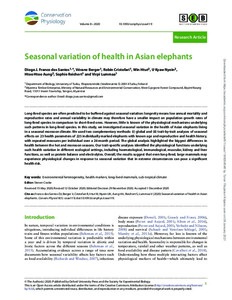Seasonal variation of health in Asian elephants
Htoo Htoo Aung; Vérane Berger; Virpi Lummaa; Sophie Reichert; Win Htut; Robin Cristofari; U Kyaw Nyein; Diogo J. Franco dos Santos
Seasonal variation of health in Asian elephants
Htoo Htoo Aung
Vérane Berger
Virpi Lummaa
Sophie Reichert
Win Htut
Robin Cristofari
U Kyaw Nyein
Diogo J. Franco dos Santos
Oxford University Press
Julkaisun pysyvä osoite on:
https://urn.fi/URN:NBN:fi-fe2021042822723
https://urn.fi/URN:NBN:fi-fe2021042822723
Tiivistelmä
Long-lived species are often predicted to be buffered against seasonal variation: longevity means low annual mortality and
reproductive rates and annual variability in climate may therefore have a smaller impact on population growth rates of
long-lived species in comparison to short-lived ones. However, little is known of the physiological mechanisms underlying
such patterns in long-lived species. In this study, we investigated seasonal variation in the health of Asian elephants living
in a seasonal monsoon climate. We used two complementary methods: (i) global and (ii) trait-by-trait analyses of seasonal
effects on 23 health parameters of 225 individually marked elephants with known age and reproductive and health history,
with repeated measures per individual over a 26-month period. The global analysis highlighted the biggest differences in
health between the hot and monsoon seasons. Our trait-specific analyses identified the physiological functions underlying
such health variation in different ecological settings, including haematological, immunological, muscular, kidney and liver
functions, as well as protein balance and electrolytes. Overall, the results suggest that even long-lived, large mammals may
experience physiological changes in response to seasonal variation that in extreme circumstances can pose a significant
health risk.
Key words: Environmental heterogeneity, health markers, long-lived mammals, sub-tropical climate
reproductive rates and annual variability in climate may therefore have a smaller impact on population growth rates of
long-lived species in comparison to short-lived ones. However, little is known of the physiological mechanisms underlying
such patterns in long-lived species. In this study, we investigated seasonal variation in the health of Asian elephants living
in a seasonal monsoon climate. We used two complementary methods: (i) global and (ii) trait-by-trait analyses of seasonal
effects on 23 health parameters of 225 individually marked elephants with known age and reproductive and health history,
with repeated measures per individual over a 26-month period. The global analysis highlighted the biggest differences in
health between the hot and monsoon seasons. Our trait-specific analyses identified the physiological functions underlying
such health variation in different ecological settings, including haematological, immunological, muscular, kidney and liver
functions, as well as protein balance and electrolytes. Overall, the results suggest that even long-lived, large mammals may
experience physiological changes in response to seasonal variation that in extreme circumstances can pose a significant
health risk.
Key words: Environmental heterogeneity, health markers, long-lived mammals, sub-tropical climate
Kokoelmat
- Rinnakkaistallenteet [19218]
